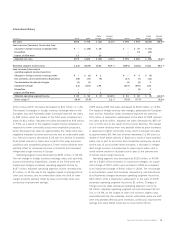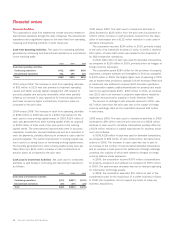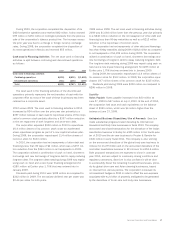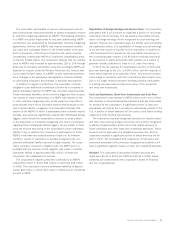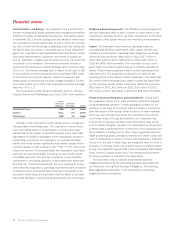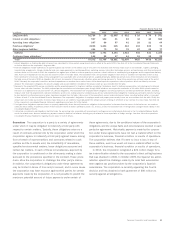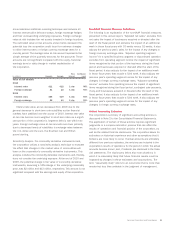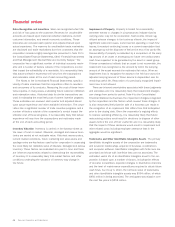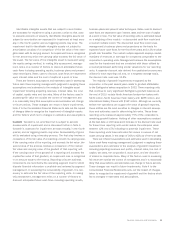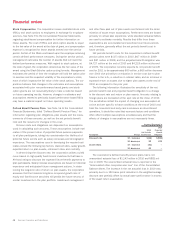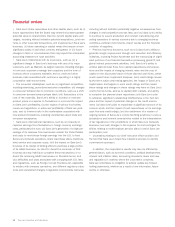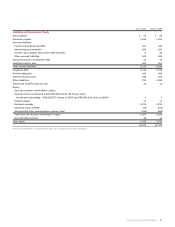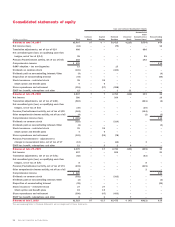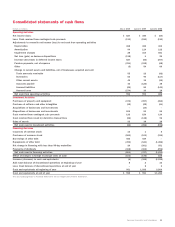Sara Lee 2010 Annual Report Download - page 47
Download and view the complete annual report
Please find page 47 of the 2010 Sara Lee annual report below. You can navigate through the pages in the report by either clicking on the pages listed below, or by using the keyword search tool below to find specific information within the annual report.Identifiable intangible assets that are subject to amortization
are evaluated for impairment using a process similar to that used
to evaluate elements of property. Identifiable intangible assets not
subject to amortization are assessed for impairment at least annu-
ally, in the fourth quarter, and as triggering events may arise. The
impairment test for identifiable intangible assets not subject to
amortization consists of a comparison of the fair value of the intan-
gible asset with its carrying amount. An impairment loss is recognized
for the amount by which the carrying value exceeds the fair value of
the asset. The fair value of the intangible asset is measured using
the royalty savings method. In making this assessment, manage-
ment relies on a number of factors to discount anticipated future
cash flows including operating results, business plans and present
value techniques. Rates used to discount cash flows are dependent
upon interest rates and the cost of capital at a point in time.
There are inherent assumptions and estimates used in developing
future cash flows requiring management’s judgment in applying these
assumptions and estimates to the analysis of intangible asset
impairment including projecting revenues, interest rates, the cost
of capital, royalty rates and tax rates. Many of the factors used in
assessing fair value are outside the control of management and
it is reasonably likely that assumptions and estimates will change
in future periods. These changes can result in future impairments.
Note 4 to the Consolidated Financial Statements sets out the impact
of charges taken to recognize the impairment of intangible assets
and the factors which led to changes in estimates and assumptions.
Goodwill Goodwill is not amortized but is subject to periodic
assessments of impairment and is discussed further in Note 3.
Goodwill is assessed for impairment at least annually, in the fourth
quarter, and as triggering events may arise. Recoverability of good-
will is evaluated using a two-step process. The first step involves a
comparison of the fair value of a reporting unit with its carrying value.
If the carrying value of the reporting unit exceeds its fair value, the
second step of the process involves a comparison of the implied
fair value and carrying value of the goodwill of that reporting unit.
If the carrying value of the goodwill of a reporting unit exceeds the
implied fair value of that goodwill, an impairment loss is recognized
in an amount equal to the excess. Reporting units are business
components one level below the operating segment level for which
discrete financial information is available and reviewed by segment
management. In evaluating the recoverability of goodwill, it is nec-
essary to estimate the fair value of the reporting units. In making
this assessment, management relies on a number of factors to
discount anticipated future cash flows including operating results,
business plans and present value techniques. Rates used to discount
cash flows are dependent upon interest rates and the cost of capital
at a point in time. The fair value of reporting units is estimated based
on a weighting of two models – a discounted cash flow model and
a market multiple model. The discounted cash flow model uses
management’s business plans and projections as the basis for
expected future cash flows for the first three years and a 2% residual
growth rate thereafter. The market multiple approach employs market
multiples of revenues or earnings for companies comparable to the
corporation’s operating units. Management believes the assumptions
used for the impairment test are consistent with those utilized by
a market participant performing similar valuations for our reporting
units. A separate discount rate derived from published sources was
utilized for each reporting unit and, on a weighted average basis,
the discount rate used was 10.2%.
The majority of goodwill impairments recognized by the
corporation in the past several years relate to goodwill attributable
to the Earthgrains bakery acquisition in 2002. Three reporting units
that continue to carry significant Earthgrains goodwill balances at
the end of 2010 include North American foodservice bakery with
$476 million, North American fresh bakery with $288 million, and
International Bakery France with $162 million. Although we currently
believe the operations can support the value of goodwill reported,
these entities are the most sensitive to changes in inherent assump-
tions and estimates used in determining fair value. These three
reporting units represent approximately 75% of the corporation’s
remaining goodwill balance. Holding all other assumptions constant
at the test date, a 100 basis point increase in the discount rate used
for these three reporting units would reduce the enterprise value
between 12% and 15% indicating no potential impairment. These
three reporting units have estimated fair values in excess of net
asset carrying values in the range of 36% to 63% as of the test date.
There are inherent assumptions and estimates used in developing
future cash flows requiring management’s judgment in applying these
assumptions and estimates to the analysis of goodwill impairment
including projecting revenues and profits, interest rates, the cost of
capital, tax rates, the corporation’s stock price, and the allocation
of shared or corporate items. Many of the factors used in assessing
fair value are outside the control of management and it is reasonably
likely that assumptions and estimates can change in future periods.
These changes can result in future impairments. Note 4 to the
Consolidated Financial Statements sets out the impact of charges
taken to recognize the impairment of goodwill and the factors which
led to changes in estimates and assumptions.
Sara Lee Corporation and Subsidiaries 45


